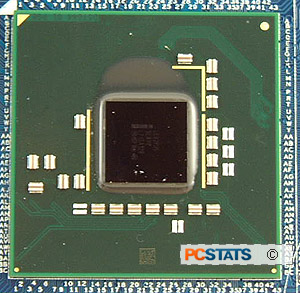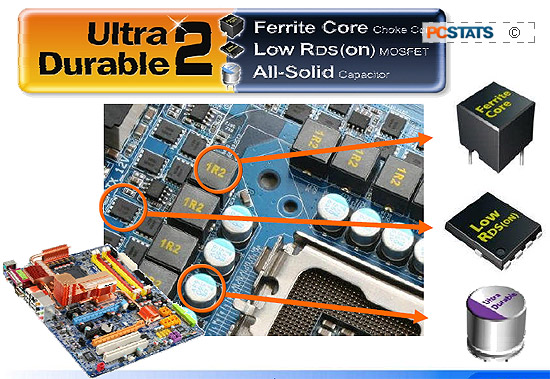The P35
Express handles all LGA775 processors running on 800/1066/1333 MHz Front Side
bus (theoretical 10.6GB/s bandwidth). The ICH9R southbridge supports RAID via
Intel's Matrix storage technology.
 |
| Intel P35 'Bearlake'
chipset. |
 With Intel projecting quad core
processors to be the mainstream choice, the boys in blue have increased CPU
Front Side Bus speeds from 1066MHz to 1333 MHz recently. An increased FSB speeds
up data communication between the processor and system bus.
With Intel projecting quad core
processors to be the mainstream choice, the boys in blue have increased CPU
Front Side Bus speeds from 1066MHz to 1333 MHz recently. An increased FSB speeds
up data communication between the processor and system bus.
Intel also modified the memory controller in the P35,
boosting DDR2 memory support to 1066 MHz and consequently increasing maximum
theoretical bandwidth to 17GB/s (in a dual channel DDR3 configuration).
These changes are all incremental, the most significant
improvement in the P35 Express chipset has been the inclusion of DDR3 RAM support. Now it is important to make the
distinction that Intel P35 Express motherboards can support either DDR3 or DDR2. The Gigabyte GA-P35-DS3R is a
DDR2 RAM platform. It is not compatible with DDR3 memory.
By default the Intel P35 Express chipset handles a
single 8GB/s PCI Express x16 videocards with 16 PCI Express lanes devoted to it.
Build Quality: Ultra
Durable 2
Gigabyte have recently changed how mainstream and
enthusiast grade motherboards are built, basically by selecting better quality
electronic components. The three electrical components covered by Gigabyte's
"Ultra Durable 2" marketing slogan are ferrite core choke coils, Low RDS
MOSFET's and All-Solid aluminum Polymer capacitors. The combination of all these
parts, according to Gigabyte, reduces component
temperature, improves power efficiency to the CPU and enhances PC stability
under load.
You may or may not recall the problem of burst capacitors that turned into an
industry wide epidemic a few years ago. These changes are born from that
epidemic. Consequently, the benefits of higher quality Japanese-made
electrolytic capacitors, and in some cases conductive polymer solid-state
aluminum capacitors has been stressed on virtually every motherboard worth its
salt since. Solid state capacitors improve overall stability, and last
significantly longer than the electrolytic variety. Given that the average
desktop motherboard lifecycle is anywhere from 6 months to 3 years, it's not
unreasonable to expect it to operate reliably for that period of time.

If you've never looked twice at motherboard and know
nothing about what all the little black and grey spots actually are, let alone
do, you're in for a treat. In the above slide are the three components of
Gigabyte's Ultra Durable 2 approach. Shown here are the Ferrite Core choke coil
(this helps filter out EMI/RF interference), the LOW RDS(on) MOSFET (power
circuitry), and the 'All-Solid' aluminum Polymer capacitors.
